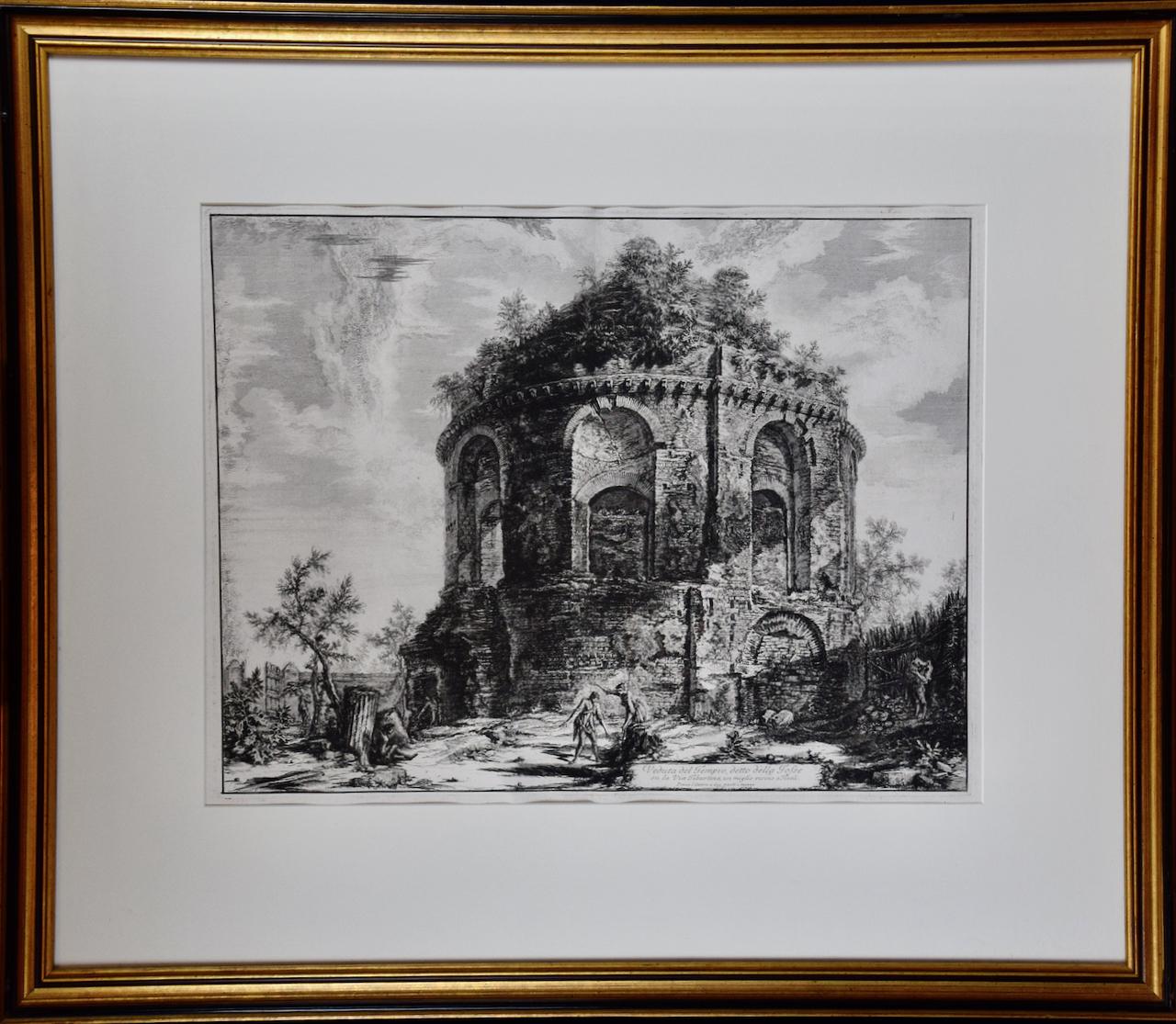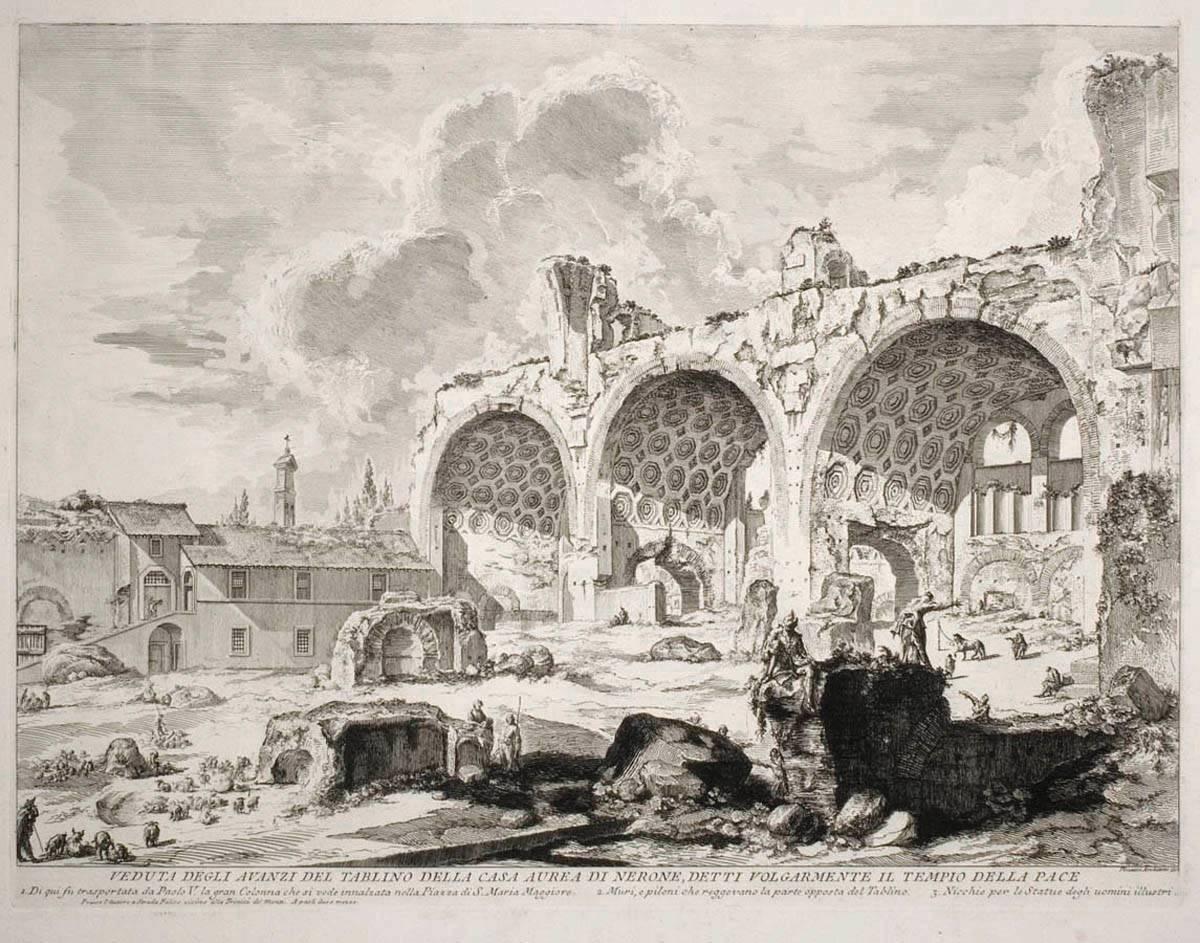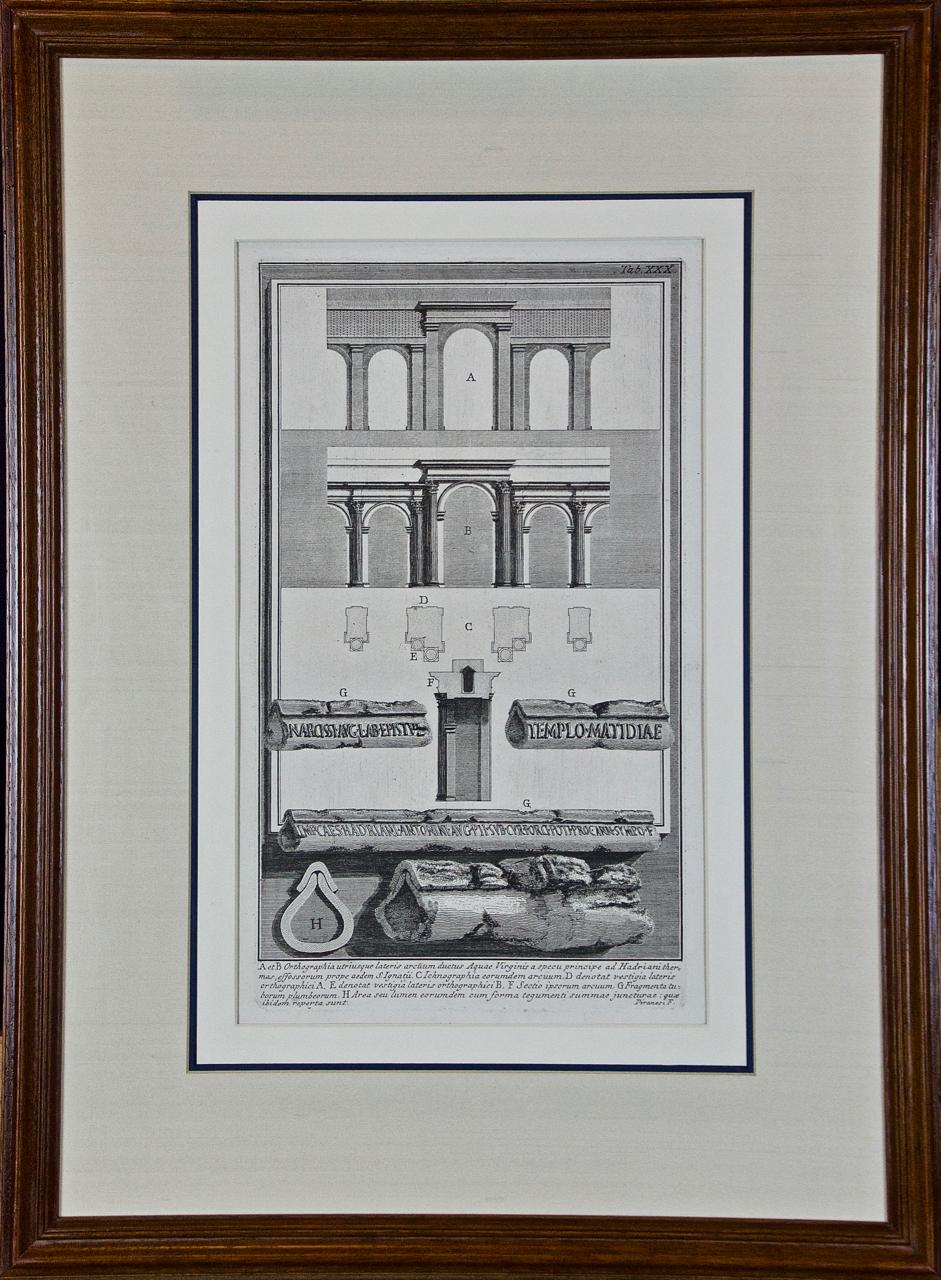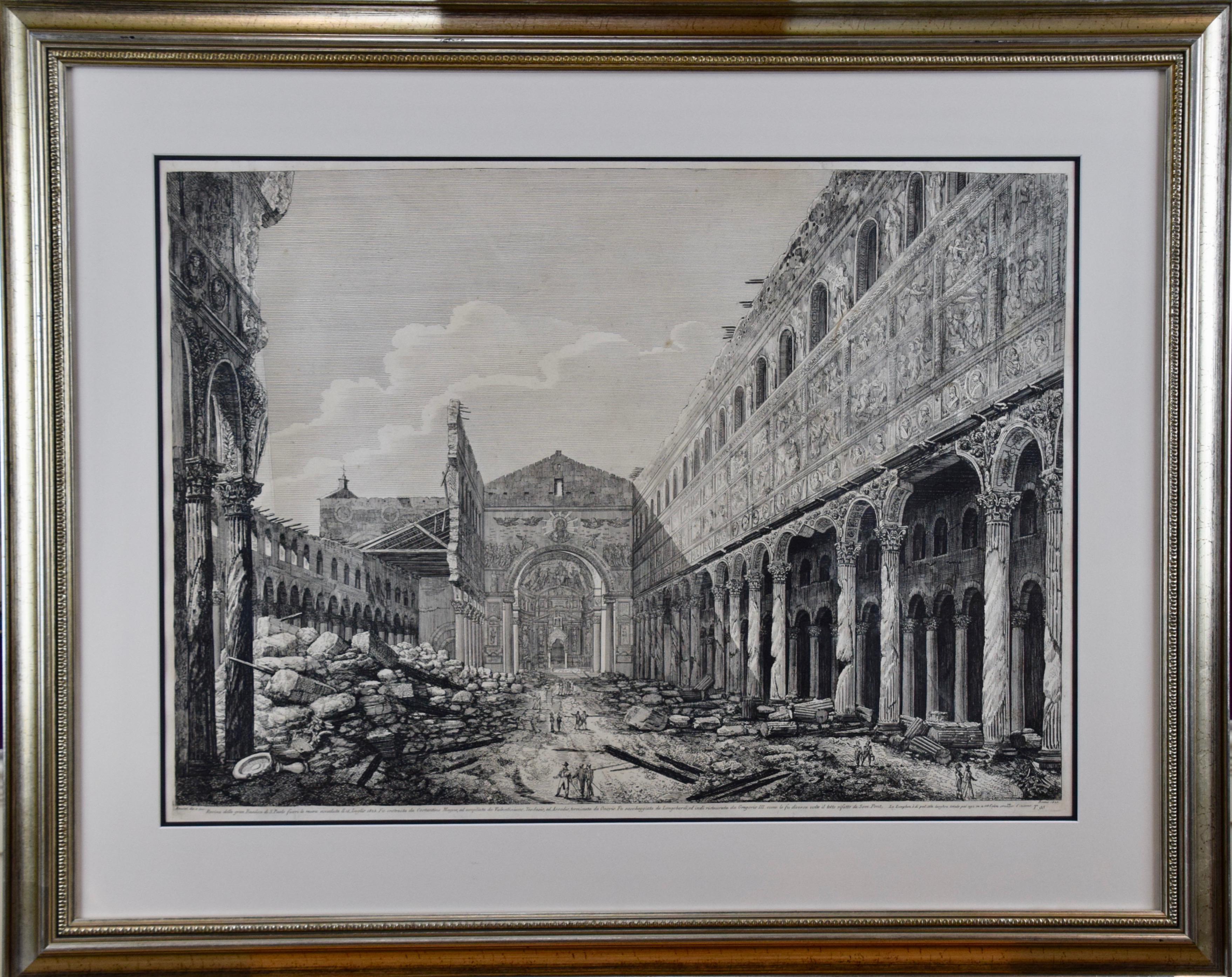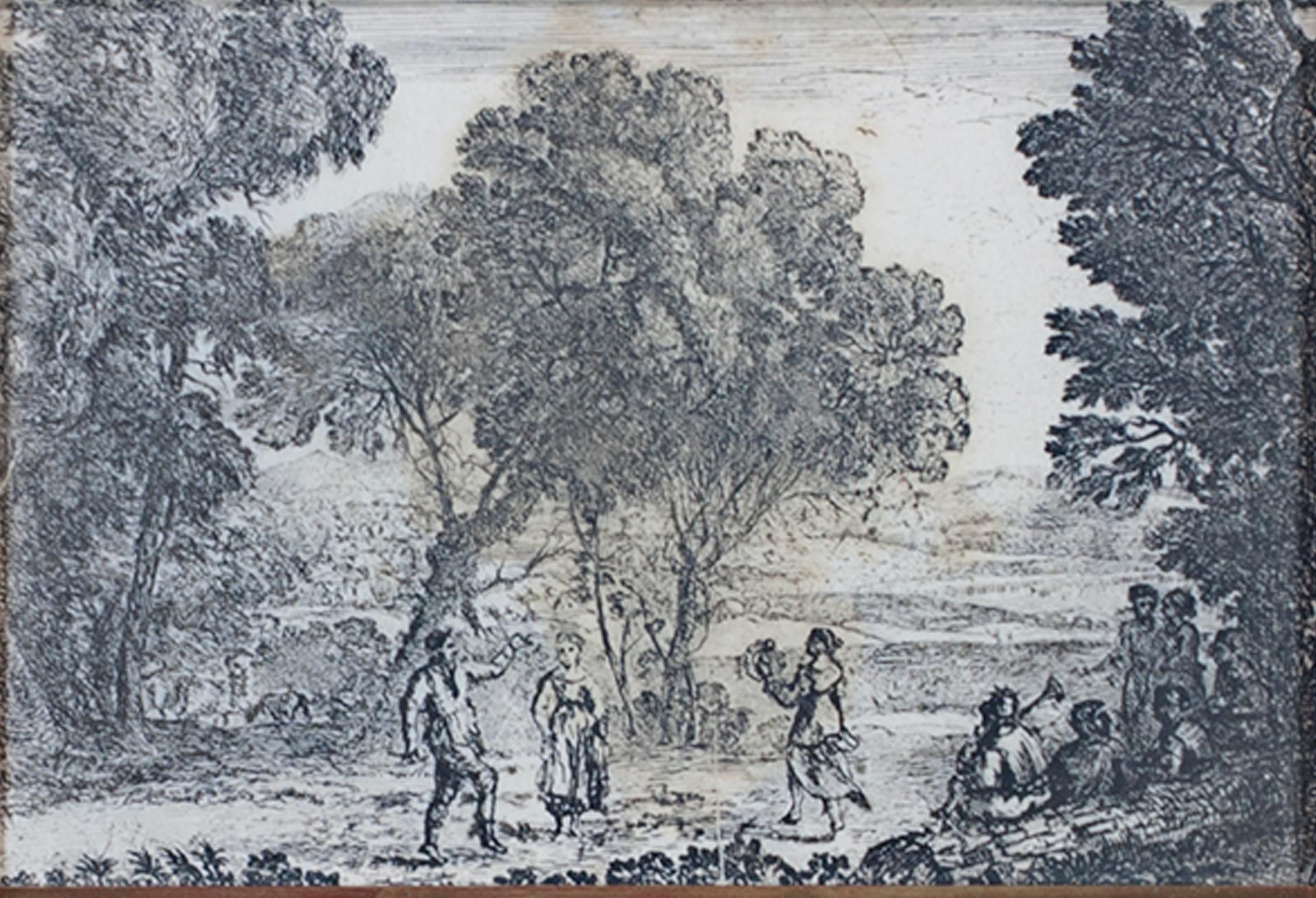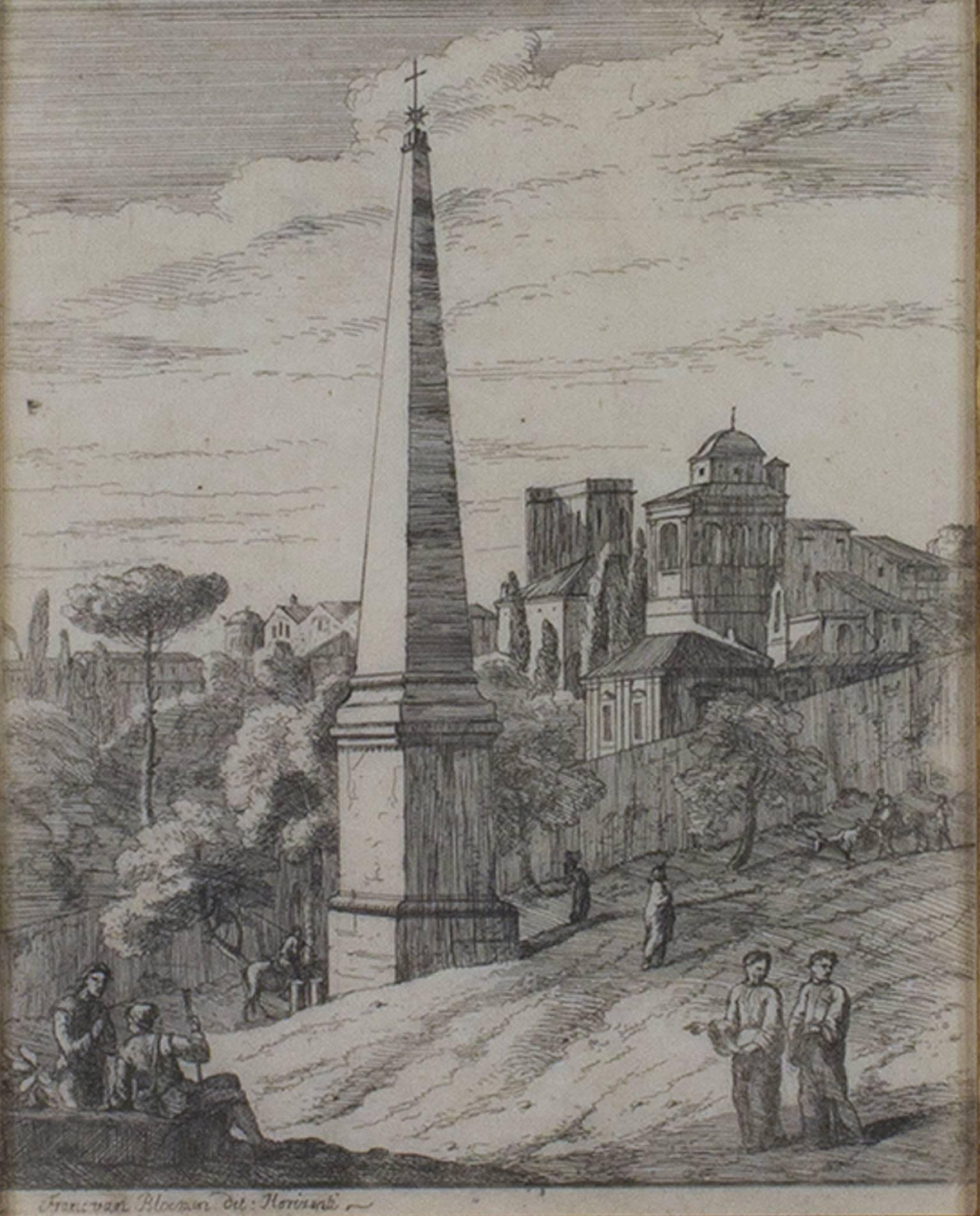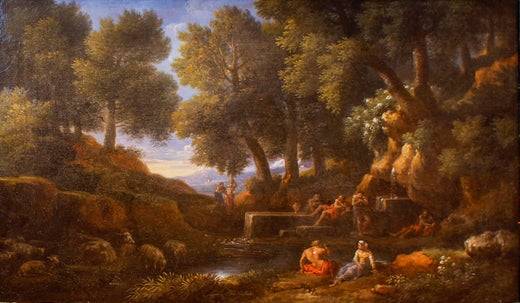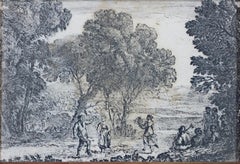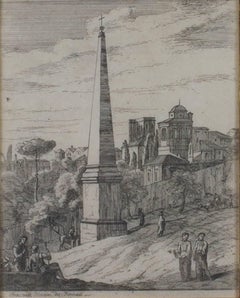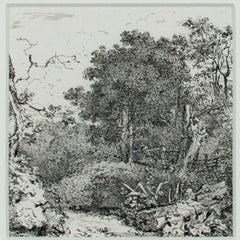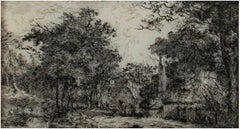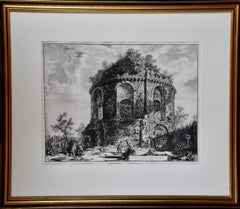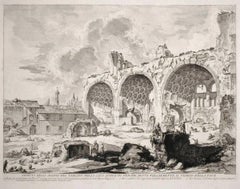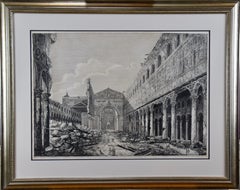Items Similar to 17th century etching black and white figurative landscape trees statues scene
Want more images or videos?
Request additional images or videos from the seller
1 of 9
Jan Frans van Bloemen (Orizzonte)17th century etching black and white figurative landscape trees statues scene1700s
1700s
About the Item
"Mother & Child Near Statues" is an original etching by Jan Frans van Bloemen. It depicts two figures, a mother and child pair, next two two classical statues. There are other figures in this park-like environment.
9 1/4" x 6 3/4" art
21 5/8" x 19 3/8" frame
Jan Frans van Bloemen (baptized 12 May 1662 - buried 13 June 1749) was a Flemish landscape painter mainly active in Rome. Here he was able to establish himself as the leading painter of views (vedute) of the Roman countryside depicted in the aesthetic of the classical landscape tradition.
Van Bloemen predominantly painted classical landscapes, taking his inspiration from the Roman Campagna. His landscapes, with their recession through a series of planes, soft, warm lightning and classical and religious subject matter, drew on the examples of artists such as Claude Lorrain and Gaspard Dughet. His paintings are exquisitely imbued with that "difficult-to-define pastoral ambience" which helped to make him such a great painter in the eyes of his contemporaries. The technique and subjects of the work of Jan Frans van Bloemen are also related to painters such as Jan Asselijn, Thomas Wyck, Willem Romeyn and Willem Schellinks. His painted vedute fall into the category of the vedute that combine reality with imaginary elements. His landscapes have an Arcadian lushness, with mountains, streams, distant hamlets, and small inhabitants painted with imprecise pittura di tocco ('painting of touch') using small dotting and spirited brush-strokes.
- Creator:Jan Frans van Bloemen (Orizzonte) (1662-1749, Flemish)
- Creation Year:1700s
- Dimensions:Height: 21.625 in (54.93 cm)Width: 19.375 in (49.22 cm)
- Medium:
- Movement & Style:
- Period:
- Condition:
- Gallery Location:Milwaukee, WI
- Reference Number:Seller: 10690g1stDibs: LU60532210283
Jan Frans van Bloemen (Orizzonte)
Jan Frans van Bloemen (baptized 12 May 1662 - buried 13 June 1749) was a Flemish landscape painter mainly active in Rome. Here he was able to establish himself as the leading painter of views (vedute) of the Roman countryside depicted in the aesthetic of the classical landscape tradition. Van Bloemen predominantly painted classical landscapes, taking his inspiration from the Roman Campagna. His landscapes, with their recession through a series of planes, soft, warm lightning and classical and religious subject matter, drew on the examples of artists such as Claude Lorrain and Gaspard Dughet. His paintings are exquisitely imbued with that "difficult-to-define pastoral ambience" which helped to make him such a great painter in the eyes of his contemporaries. The technique and subjects of the work of Jan Frans van Bloemen are also related to painters such as Jan Asselijn, Thomas Wyck, Willem Romeyn and Willem Schellinks. His painted vedute fall into the category of the vedute that combine reality with imaginary elements. His landscapes have an Arcadian lushness, with mountains, streams, distant hamlets, and small inhabitants painted with imprecise pittura di tocco ('painting of touch') using small dotting and spirited brush-strokes. Unlike van Wittel, van Bloemen did not generally depict views of areas distant from Rome such as the Tiber valley or the Alban hills. His subjects were limited to views in the immediate vicinity of Rome, an outline of which was typically visible in his compositions. Van Bloemen was in particular known for his 'estate views' representing the estates of the nobility in the Roman Campagna. His views aim to associate the modern estate view with the classical arcadian landscape. Rather than offering the wide panoramic views, distant horizon and atmospheric effects associated with topographical landscapes, van Bloemen's estate views emphasize minute observation of reality and a limited viewpoint. The estates are thus made to appear as immutable features of the local landscape. He worked together with other painters who painted the figures in his landscapes such as Carlo Maratti, Placido Costanzi and Pompeo Batoni. However, he only relied on such collaboration with figure painters in the last decades of his life when he produced his most ambitious classicising compositions. Even then he only relied on these figure specialists for the most prominent figures in the foreground while he took care of the minor characters. In fact, van Bloemen was an accomplished staffage painter and he was very skilled at quickly learning to imitate the style of his collaborators. As a result, many of the figures in his paintings that are attributed to prestigious contemporaries were actually by his own hand. His landscape drawings, which often depict imaginary ruins, have been confused with those of his brother Pieter, who is better known for his drawings of figures and animals. Jan Frans van Bloemen also made pen drawings of buildings in and around Rome.
About the Seller
4.9
Gold Seller
Premium sellers maintaining a 4.3+ rating and 24-hour response times
Established in 1966
1stDibs seller since 2017
429 sales on 1stDibs
Typical response time: 2 hours
- ShippingRetrieving quote...Shipping from: Milwaukee, WI
- Return Policy
Authenticity Guarantee
In the unlikely event there’s an issue with an item’s authenticity, contact us within 1 year for a full refund. DetailsMoney-Back Guarantee
If your item is not as described, is damaged in transit, or does not arrive, contact us within 7 days for a full refund. Details24-Hour Cancellation
You have a 24-hour grace period in which to reconsider your purchase, with no questions asked.Vetted Professional Sellers
Our world-class sellers must adhere to strict standards for service and quality, maintaining the integrity of our listings.Price-Match Guarantee
If you find that a seller listed the same item for a lower price elsewhere, we’ll match it.Trusted Global Delivery
Our best-in-class carrier network provides specialized shipping options worldwide, including custom delivery.More From This Seller
View All17th century etching black and white landscape scene forest trees figures sky
By Claude Lorrain
Located in Milwaukee, WI
"La Danse Sous Les Arbes (The Country Dance)" is an etching by Claude Gellee (Le Lorrain). This etching is in the collections of the Metropolitan Museum and the Louvre. Publisher: Ma...
Category
Mid-17th Century Old Masters Landscape Prints
Materials
Etching
17th century etching black and white figurative landscape obelisk buildings
By Jan Frans van Bloemen (Orizzonte)
Located in Milwaukee, WI
"Figures at the Obelisk" is an original etching by Jan Frans van Bloemen. It depicts two people conversing in front of a monument. Behind them, an expansive landscape sprawls.
9 1/4" x 6 3/4" art
21 3/4" x 19 3/8" frame
Jan Frans van Bloemen (baptized 12 May 1662 - buried 13 June 1749) was a Flemish landscape painter mainly active in Rome. Here he was able to establish himself as the leading painter of views (vedute) of the Roman countryside depicted in the aesthetic of the classical landscape tradition.
Van Bloemen predominantly painted classical landscapes, taking his inspiration from the Roman Campagna. His landscapes, with their recession through a series of planes, soft, warm lightning and classical and religious subject matter, drew on the examples of artists such as Claude Lorrain and Gaspard Dughet. His paintings are exquisitely imbued with that "difficult-to-define pastoral ambience" which helped to make him such a great painter in the eyes of his contemporaries. The technique and subjects of the work of Jan Frans van Bloemen are also related to painters such as Jan Asselijn, Thomas Wyck...
Category
18th Century Old Masters Landscape Prints
Materials
Etching
"Forest Glen, " Etching Landscape initialed in Plate by John Thomas Smith
By John Thomas Smith
Located in Milwaukee, WI
"Forest Glen" is an original etching by John Thomas Smith. The piece was initialed in plate. It depicts a small inlet to a lush forest.
3 5/8" x 3 1/2" art
12 7/8" x 12 3/4" frame
...
Category
1790s Old Masters Landscape Prints
Materials
Etching
"Country Inn by the Pond, " Etching by John Thomas Smith
By John Thomas Smith
Located in Milwaukee, WI
"Country Inn by the Pond" is an original etching by John Thomas Smith. It depicts a cozy building surrounded by trees and vegetation and next to a pond.
3" x 5 1/4" art
16" x 18 1/...
Category
1790s Old Masters Landscape Prints
Materials
Etching
18th century landscape etching pastoral house nature scene detailed ink trees
By John Thomas Smith
Located in Milwaukee, WI
"Near Mill Hill, Gravesend" is an original etching by John Thomas Smith. It depicts a cottage and farmstead with a few small figures. The piece is titled on ...
Category
1790s Old Masters Landscape Prints
Materials
Etching
17th century etching black and white figurative landscape trees buildings
By Jan Frans van Bloemen (Orizzonte)
Located in Milwaukee, WI
"Conversation Outside Castle" is an original etching by Jan Frans van Bloemen. It depicts a number of figures just outside the majestic walls of a castle. These groups of figures are engaged in their own conversations.
9" x 6 3/4" art
21 5/8" x 19 3/8" frame
Jan Frans van Bloemen (baptized 12 May 1662 - buried 13 June 1749) was a Flemish landscape painter mainly active in Rome. Here he was able to establish himself as the leading painter of views (vedute) of the Roman countryside depicted in the aesthetic of the classical landscape tradition.
Van Bloemen predominantly painted classical landscapes, taking his inspiration from the Roman Campagna. His landscapes, with their recession through a series of planes, soft, warm lightning and classical and religious subject matter, drew on the examples of artists such as Claude Lorrain and Gaspard Dughet. His paintings are exquisitely imbued with that "difficult-to-define pastoral ambience" which helped to make him such a great painter in the eyes of his contemporaries. The technique and subjects of the work of Jan Frans van Bloemen are also related to painters such as Jan Asselijn...
Category
18th Century Old Masters Landscape Prints
Materials
Etching
You May Also Like
Ancient Roman Temple Architecture: An 18th Century Framed Etching by Piranesi
By Giovanni Battista Piranesi
Located in Alamo, CA
This is an 18th century etching by Giovanni Battista Piranesi entitled "Veduta del Tempio detto della Tosse su la Via Tiburtina, un miglio vicino a Tivoli" (View of the so-called Tem...
Category
1760s Old Masters Figurative Prints
Materials
Etching
The Basilica of Constantine
By Giovanni Battista Piranesi
Located in Chicago, IL
A very fine impression of the 3rd State, still with the address and price which were eliminated in the following 4th state. The presence of the address and price confirms that this ...
Category
18th Century and Earlier Old Masters Landscape Prints
Materials
Etching
Piranesi Etching of Hadrian's Ancient Roman Aqueduct and Baths, "Aquae Virginis"
By Giovanni Battista Piranesi
Located in Alamo, CA
This is a framed Giovanni Battista Piranesi (1720-1778) etching entitled "Orthographia utriusque lateris arcuum ductus Aquae Virginis a specu principe ad Hadriani thermas, effossorum...
Category
Mid-18th Century Old Masters Landscape Prints
Materials
Etching
The Basilica of St. Paul in Rome, Early 19th Century Etching by Luigi Rossini
By Luigi Rossini
Located in Alamo, CA
"Rovina della gran Basilica di S. Paolo fueri le mura accaduta" (View of the Ruins of the Great Triumphal Arch of S. Paolo Fuori le Mura) from "Le Antichita Romane" (Ancient Rome), published in Rome in 1823. It depicts the destruction of the Basilica of St. Paul after the fire of 1823. People stand in the road and on the right observing the damage amid debris, which includes many fragments of columns.
The etching is presented in a silver-color wood frame with an off-white double mat with a black inner mat. There are a few small spots, but it is otherwise in very good condition. See item # LU117324669722 for another Rossini etching...
Category
1820s Old Masters Figurative Prints
Materials
Etching
Avanzi di un Gran Salone nel piano terra della Villa di Mecenate in Tivoli
By Luigi Rossini
Located in Roma, IT
Like G.B.Piranesi, Rossini, well know as the “Piranesi’s heir”, trained as an architect and his etchings have the same tendency to emphasize the massive structure of the Ancient Rome...
Category
1820s Old Masters Figurative Prints
Materials
Etching
Shere Mill Pond
By Sir Francis Seymour Haden, R.A.
Located in Missouri, MO
Shere Mill Pond, No. II (large plate). 1860. Etching and drypoint. Schneiderman 37.v/ix. 7 x 13 1/8 (sheet 10 3/4 x 16 3/8). This state is prior to publication in Études à l'Eau-Forte. Illustrated: Keppel The Golden Age of Engraving; Print Collector's Quarterly 1 (1911): 18; : Guichard, British Etchers, 1850-1940. A rich, brilliant proof with drypoint burr printed on white laid paper. Signed in pencil.
-------------------------------------------------------------------------------------------
Shere Mill Pond, No. II was one of the most highly praised landscape prints of the etching revival. An impression was exhibited at the Royal Academy in 1861 under Haden’s pseudonym, H. Dean. Francis Seymour Haden used this anagram of his own name early in his career as an artist, in order to retain his anonymity and preserve his professional reputation as a surgeon.
Biography:
Sir Francis Seymour Haden (16 September 1818 - 1 June 1910), was an English surgeon, best known as an etcher.
He was born in London, his father, Charles Thomas Haden, being a well-known doctor and lover of music. He was educated at Derby School, Christ's Hospital, and University College, London, and also studied at the Sorbonne, Paris, where he took his degree in 1840. He was admitted as a member of the College of Surgeons in London in 1842.
In 1843-1844, with his friends Duval, Le Cannes and Colonel Guibout, he travelled in Italy and made his first sketches from nature. Haden attended no art school and had no art teachers, but between 1845 and 1848 he studied portfolios of prints belonging to a second-hand dealer named Love, who had a shop in Bunhill Row, the old Quaker quarter of London. Arranging the prints in chronological order, he studied the works of the great original engravers, Albrecht Dürer, Lucas van Leyden and Rembrandt. These studies, besides influencing his original work, led to his important monograph on the etched work of Rembrandt. By lecture and book, and with the aid of the memorable exhibition at the Burlington Fine Arts Club in 1877, he tried to give a true reflection of Rembrandt's work, giving a nobler idea of the master's mind by taking away from the list of his works many dull and unseemly plates that had long been included in the lists. His reasons were founded upon the results of a study of the master's works in chronological order, and are clearly expressed in his monograph, The Etched Work of Rembrandt critically reconsidered, privately printed in 1877, and in The Etched Work of Rembrandt True and False (1895).
Haden's printmaking was invigorated by his much younger brother-in-law, James Whistler, at the Haden home in Sloane Street in 1855. A press was installed there and for a while Haden and Whistler collaborated on a series of etchings of the Thames. The relationship and project did not last.
Haden followed the art of original etching with such vigour that he became not only the foremost British exponent of that art but brought about its revival in England. His strenuous efforts and perseverance, aided by the secretarial ability of Sir WR Drake, resulted in the foundation of the Royal Society of Painter-Etchers and Engravers. As president he ruled the society with a strong hand from its first beginnings in 1880.
Notwithstanding his study of the old masters of his art, Haden's own plates were very individual, and are particularly noticeable for a fine original treatment of landscape subjects, free and open in line, clear and well divided in mass, and full of a noble and dignified style of his own. Even when working from a picture his personality dominates the plate, as for example in the large plate he etched after J.M.W. Turner's "Calais Pier," which is a classical example of what interpretative work can do in black and white. Of his original plates, more than 250 in number, one of the most notable was the large "Breaking up of the Agamemnon."
An early plate, rare and most beautiful, is "Thames Fisherman". "Mytton Hall" is broad in treatment, and a fine rendering of a shady avenue of yew trees leading to an old manor-house in sunlight. "Sub Tegmine" was etched in Greenwich Park in 1859; and "Early Morning--Richmond", full of the poetry and freshness of the hour, was done, according to Haden, actually at sunrise. One of the rarest and most beautiful of his plates is "A By-Road in Tipperary"; "Combe Bottom" is another; and "Shere Mill Pond" (both the small study and the larger plate), "Sunset in Ireland," "Penton Hook," "Grim Spain" and "Evening Fishing, Longparish," are also notable examples of his genius. A catalogue of his works was begun by Sir William Drake and completed by Harrington in 1880. During later years Haden began to practise the sister art...
Category
Late 19th Century Old Masters Landscape Prints
Materials
Drypoint, Etching
